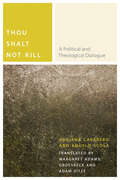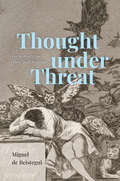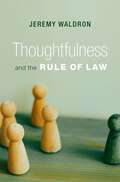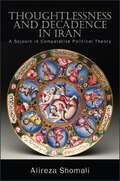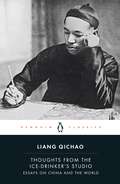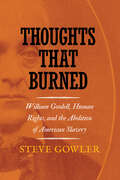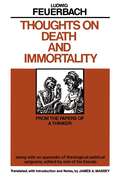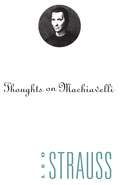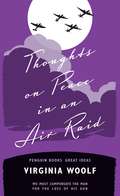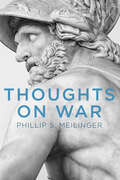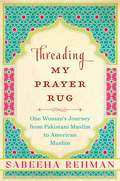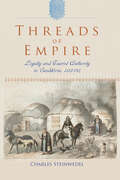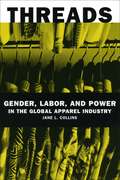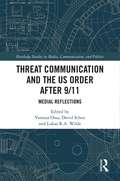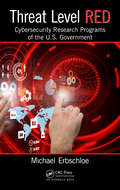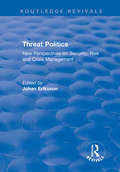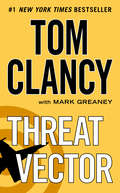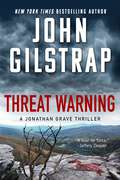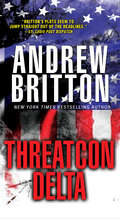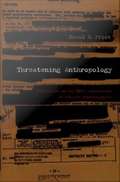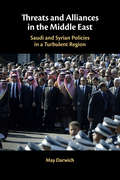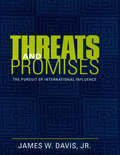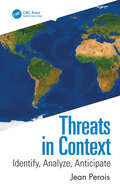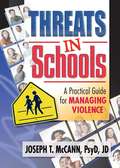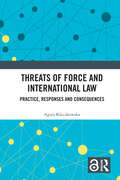- Table View
- List View
Thou Shalt Not Kill: A Political and Theological Dialogue (Commonalities)
by Adriana Cavarero Angelo ScolaIn this fascinating and rare little book, a leading Italian feminist philosopher and the Archbishop of Milan face off over the contemporary meaning of the biblical commandment not to kill.The result is a series of erudite and wide-ranging arguments that move from murder and suicide to just war and drone strikes, from bioethics and biopolitics to hermeneutics and philology, from Theodor Adorno and Max Horkheimer to Hannah Arendt and Michel Foucault, from Torah and Scripture to art and literature, from the essence of human dignity and the paradoxes of fratricide to engagements with Levinasian ethics.Less a direct debate than a disputation in the classical sense, Thou Shalt Not Kill proves to be a searching meditation on one of the unstated moral premises shared by otherwise bitterly opposed political factions. It will stimulate the mind of the novice while also reminding more advanced readers of the necessity and desirability of thinking in the present.
Thought under Threat: On Superstition, Spite, and Stupidity
by Miguel de BeisteguiThought under Threatreveals and combats the forces diminishing the power and role of critical thinking, whether in our individual lives or collectively.Thought under Threat is an attempt to understand the tendencies that threaten thinking from within. These tendencies have always existed. But today they are on the rise and frequently encouraged, even in our democracies. People “disagree” with science and distrust experts. Political leaders appeal to the hearts and guts of “the people,” rather than their critical faculties. Stupidity has become a right, if not a badge of honor; superstition is on the rise; and spite is a major political force. Thinking is considered “elitist.” To see those obstacles as vices of thought, Miguel de Beistegui argues, we need to understand stupidity not as a lack of intelligence or judgment, but as the tendency to raise false problems and trivial questions. Similarly, we need to see spite not as a moral vice, but as a poison that blurs and distorts our critical faculties. Finally, superstition is best described not as a set of false beliefs, but as a system that neutralizes one’s ability to think for oneself. For de Beistegui, thinking is intrinsically democratic and a necessary condition for the exercise of freedom. Thought under Threat shows how a training of thought itself can be used to ward off those vices, lead to productive deliberation, and, ultimately, create a thinking community.
Thoughtfulness and the Rule of Law
by Jeremy WaldronAn essential study of the rule of law by one of the world’s leading liberal political and legal philosophers.The meaning and value of the rule of law have been debated since antiquity. For many, the rule of law has become the essence of good government. But Jeremy Waldron takes a different view, arguing that it is but one star in a constellation of ideals that define our political morality, ranking alongside democracy, human rights, economic freedom, and social justice.This timely essay collection, from one of the most respected political philosophers of his generation, is a brief on behalf of thoughtfulness: the intervention of human intelligence in the application of law. Waldron defends thoughtfulness against the claim that it threatens to replace the rule of law with the arbitrary rule of people. To the contrary, he argues, the rule of law requires thoughtfulness: it is impossible to apply a standard such as “reasonableness” on the basis of rules alone, and common legal activities like arguing in court and reasoning from precedents are poorly served by algorithmic logics. This rich compilation also addresses the place of law in protecting human dignity, the relation between rule of law and legislation, and whether vagueness in the law is at odds with law’s role in guiding action.Thoughtfulness and the Rule of Law emphasizes the value of procedures rather than the substance or outcome of legal decisions. Challenging the view that predictability and clarity are cardinal virtues, Waldron shows that real-world controversies often are best approached using a relatively thin concept of the rule of law, together with the thoughtfulness that a legal system frames and enables.
Thoughtlessness and Decadence in Iran: A Sojourn in Comparative Political Theory
by Alireza ShomaliPolitical decay in Islamic societies has for the most part been the subject of structural analyses while philosophical studies have been rare, often speculative and deterministic. Thoughtlessness and Decadence in Iran explores from a theoretical perspective the problem of democracy deficit—or, political decadence—in contemporary Iran and, by implication, in present-day Middle Eastern societies. This decadence, the book argues, is in part a religion-based decadence, and deliverance from it requires collective thoughtfulness about religion. Alireza Shomali conceptualizes the Iranian Reality in terms of a lack of not only good life but also thinking of good living. This thoughtlessness means dissolution of critical consciousness and, as such, it heralds escalating decadence. At this moment of rapid decay, the book argues, thought must become relevant to society: the communicative practice of thinking must emerge to examine the pathologies of a religiously administrated life. Opening a dialogue between Adorno, Strauss, Farabi and Razi, among others, Shomali underlines the critical points of similarity and difference between these thinkers and envisions a "local" emancipatory project that, noting the specifics of the Iranian case, takes lessons from the Western experience without blind imitation.
Thoughts From the Ice-Drinker's Studio: Essays on China and the World
by Liang Qichao'China's first iconic modern intellectual. His lucid and prolific writings, touching on all major concerns in his own time and anticipating many in the future, inspired several generations of thinkers' Pankaj Mishra'A country does not become corrupt and weak overnight. Rather, we are now reaping the evil harvest of what previous generations sowed.'The power, anger and fluency of Liang Qichao's writings make him one of the towering figures in modern Chinese literature. He saw his great, almost unmanageable task as an attempt to write China into the new era - to provide an ancient country, devastated by civil war and foreign predators, with the intellectual equipment to renew itself.Liang said that he wrote from an 'ice-drinker's studio', implying that underneath his dispassionate, disabused and rational tone lay an ardour and passion which only ice could cool. China could only recover through a clear-sighted, informed understanding of its enemies - and by engaging in a thorough-going self-critique. Liang did not propose aping the West but taking only what China needed to 'renew the people' and create 'new citizens'. Then China would be able to expel its invaders, reform its society and become a great power once more.This selection of pieces shows Liang's extraordinary range and the burning sense of mission which drove him on, attempting to galvanize and refresh an entire nation. Blending together Confucianism, Buddhism and the Western Enlightenment, Liang's ideas about nation, democracy, and morality had a profound impact on Chinese visions of the political order, though the China that eventually emerged from the further disasters of the 1930s and 1940s would be a very different one.
Thoughts That Burned: William Goodell, Human Rights, and the Abolition of American Slavery
by Steve GowlerIn Thoughts That Burned, Steve Gowler showcases the life of William Goodell, one of the most significant leaders of the antebellum antislavery movement. Between 1826 and 1864, Goodell edited more than a dozen reform newspapers and played a leading role in the formation of several organizations, including the American Anti-slavery Society, the Liberty Party, the American Missionary Association, and the Radical Abolition Party. His 1852 book Slavery and Anti-slavery was the first comprehensive history of the antislavery movement written by an American.Convinced that the logic of slavery needed to be investigated and laid bare, Goodell explored the institution's deep structures. Whereas many abolitionists based their arguments on the inhumane consequences of enslavement, Goodell analyzed the legal and psychological relations constituting the slave system. At the heart of this analysis was his close reading of Southern slave codes and of the United States Constitution. He argued that the Constitution, properly understood, is incompatible with slavery and should be used as an instrument of emancipation. Among those influenced by his constitutional hermeneutic was Frederick Douglass, who described Goodell as the man "to whom the cause of liberty in America is as much indebted as to any other one American citizen." Thoughts That Burned is the first comprehensive biography of this extraordinary thinker, whose powerful political and theological arguments grounded abolition within the concept of human rights.
Thoughts on Death and Immortality: From the Papers of a Thinker, along with an Appendix of Theological Satirical Epigrams, Edited by One of his Friends
by Ludwig FeuerbachNever translated before, 'Thoughts on Death and Immortality' was the first published work of Ludwig Feuerbach (1804-1872). The scandal created by portrayal of Christianity as an egoistic and inhumane religion cost the young Hegelian his job and, to some extent, his career. Joining philosophical argument to epigram, lyric, and satire, the work has three central arguments: first, a straightforward denial of the Christian belief in personal immortality; second, a plea for recognition of the inexhaustible quality of the only life we have; and third, a derisive assault on the posturings and hypocrisies of the professional theologians of nineteenth-century Germany.
Thoughts on Machiavelli
by Leo StraussLeo Strauss argued that the most visible fact about Machiavelli's doctrine is also the most useful one: Machiavelli seems to be a teacher of wickedness. Strauss sought to incorporate this idea in his interpretation without permitting it to overwhelm or exhaust his exegesis of The Prince and the Discourses on the First Ten Books of Livy. "We are in sympathy," he writes, "with the simple opinion about Machiavelli [namely, the wickedness of his teaching], not only because it is wholesome, but above all because a failure to take that opinion seriously prevents one from doing justice to what is truly admirable in Machiavelli: the intrepidity of his thought, the grandeur of his vision, and the graceful subtlety of his speech." This critique of the founder of modern political philosophy by this prominent twentieth-century scholar is an essential text for students of both authors.
Thoughts on Peace in an Air Raid
by Virginia Woolf'The Germans were over this house last night and the night before that. Here they are again. It is a queer experience, lying in the dark and listening to the zoom of a hornet, which may at any moment sting you to death. It is a sound that interrupts cool and consecutive thinking about peace. Yet it is a sound - far more than prayers and anthems - that should compel one to think about peace. Unless we can think peace into existence we - not this one body in this one bed but millions of bodies yet to be born - will lie in the same darkness and hear the same death rattle overhead.'Throughout history, some books have changed the world. They have transformed the way we see ourselves - and each other. They have inspired debate, dissent, war and revolution. They have enlightened, outraged, provoked and comforted. They have enriched lives - and destroyed them. Now Penguin brings you the works of the great thinkers, pioneers, radicals and visionaries whose ideas shook civilization and helped make us who we are.
Thoughts on War
by Phillip S. Meilinger“A remarkable work that challenges the received wisdom of Clausewitz’s On War . . . [a] paradigm as to how to wage combat in our modern global environment.” —John A. English, author of Monty and the Canadian ArmyWar is changing. Unlike when modern military doctrine was forged, the United States no longer mobilizes massive land forces for direct political gain. Instead, the US fights small, overseas wars by global mandate to overthrow dictators, destroy terrorist groups, and broker regional peace. These conflicts hardly resemble the total wars fought and expected by foundational military theorists such as Carl von Clausewitz, yet their paradigms are ingrained in modern thinking. The twenty-first-century’s new geopolitical situation demands new principles for warfare—deemphasizing decisive land victory in favor of airpower, intelligence systems, and indigenous ground forces.In Thoughts on War, Phillip S.Meilinger confronts the shortcomings of US military dogma in search of a new strategic doctrine. Inter-service rivalries and conventional theories failed the US in lengthy Korea, Vietnam, and Middle East conflicts. Jettisoning traditional perspectives and their focus on decisive battles, Meilinger revisits historical campaigns looking for answers to more persistent challenges—how to coordinate forces, manipulate time, and fight on two fronts. This provocative collection of new and expanded essays offers a fresh, if controversial, perspective on time-honored military values, one which encourages a critical revision of US military strategy.“Meilinger presents a new strategic and operational paradigm for how to fight and win tomorrow’s wars with reduced risk and cost. This book will appeal not only to military professionals, but to scholars and civilian policymakers as well.” —Colonel John Andreas Olsen, Royal Norwegian Air Force, author of Airpower Pioneers
Threading My Prayer Rug: One Woman's Journey from Pakistani Muslim to American Muslim
by Sabeeha RehmanONE OF BOOKLIST'S TOP TEN RELIGION AND SPIRITUALITY BOOKS OF 2016ONE OF BOOKLIST'S TOP TEN DIVERSE NONFICTION BOOKS OF 2017Honorable Mention in the 2017 San Francisco Book Festival Awards, Spiritual CategoryThis enthralling story of the making of an American is also a timely meditation on being Muslim in America today.Threading My Prayer Rug is a richly textured reflection on what it is to be a Muslim in America today. It is also the luminous story of many journeys: from Pakistan to the United States in an arranged marriage that becomes a love match lasting forty years; from secular Muslim in an Islamic society to devout Muslim in a society ignorant of Islam, and from liberal to conservative to American Muslim; from student to bride and mother; and from an immigrant intending to stay two years to an American citizen, business executive, grandmother, and tireless advocate for interfaith understanding.Beginning with a sweetly funny, moving account of her arranged marriage, the author undercuts stereotypes and offers the refreshing view of an American life through Muslim eyes. In chapters leavened with humor, hope, and insight, she recounts an immigrant’s daily struggles balancing assimilation with preserving heritage, overcoming religious barriers from within and distortions of Islam from without, and confronting issues of raising her children as Muslims-while they lobby for a Christmas tree! Sabeeha Rehman was doing interfaith work for Imam Feisal Abdul Rauf, the driving force behind the Muslim community center at Ground Zero, when the backlash began. She discusses what that experience revealed about American society.
Threads of Empire: Loyalty and Tsarist Authority in Bashkiria, 1552–1917
by Charles SteinwedelA history and analysis of Bashkiria and its transformation into a Russian imperial region of the course of three and a half centuries.Threads of Empire examines how Russia’s imperial officials and intellectual elites made and maintained their authority among the changing intellectual and political currents in Eurasia from the mid-sixteenth century to the revolution of 1917. The book focuses on a region 750 miles east of Moscow known as Bashkiria. The region was split nearly evenly between Russian and Turkic language speakers, both nomads and farmers. Ufa province at Bashkiria’s core had the largest Muslim population of any province in the empire. The empire’s leading Muslim official, the mufti, was based there, but the region also hosted a Russian Orthodox bishop. Bashkirs and peasants had different legal status, and powerful Russian Orthodox and Muslim nobles dominated the peasant estate. By the twentieth century, industrial mining and rail commerce gave rise to a class structure of workers and managers. Bashkiria thus presents a fascinating case study of empire in all its complexities and of how the tsarist empire’s ideology and categories of rule changed over time.“An original and well-researched study of the incorporation of the Bashkir lands and their transformation into a Russian imperial region over the course of three and a half centuries. Steinwedel argues that the history of Bashkiria exposes a number of the empire’s achievements as a multiethnic society. . . . He draws out both important shifts and abiding continuities in the history of the region [and] by employing a multi-dimensional approach, covering a range of intersecting topics, provides a fuller appreciation for the region. He also does a nice job pointing out the useful commonalities and differences between the Bashkir lands and other parts of the empire, making a compelling case for Bashkiria’s importance for understanding larger processes.” —Willard Sunderland, author of Taming the Wild Field: Colonization and Empire on the Russian Steppe“With its solid grounding in Russian archival and printed sources and its sophisticated comparative approach, Steinwedel’s work will serve as a point of departure for historians of the Russian Empire, and will become a book of reference for any future study of empires in global history.” —American Historical Review“[Steinwedel’s] book is both a skilful exercise in local and regional history, and an important contribution to the history of Imperial Russia as a whole.” —Slavonic and East European Review
Threads: Gender, Labor, and Power in the Global Apparel Industry
by Jane L. CollinsAmericans have been shocked by media reports of the dismal working conditions in factories that make clothing for U. S. companies. But while well intentioned, many of these reports about child labor and sweatshop practices rely on stereotypes of how Third World factories operate, ignoring the complex economic dynamics driving the global apparel industry. To dispel these misunderstandings, Jane L. Collins visited two very different apparel firms and their factories in the United States and Mexico. Moving from corporate headquarters to factory floors, her study traces the diverse ties that link First and Third World workers and managers, producers and consumers. Collins examines how the transnational economics of the apparel industry allow firms to relocate or subcontract their work anywhere in the world, making it much harder for garment workers in the United States or any other country to demand fair pay and humane working conditions. Putting a human face on globalization, Threads shows not only how international trade affects local communities but also how workers can organize in this new environment to more effectively demand better treatment from their distant corporate employers.
Threat Communication and the US Order after 9/11: Medial Reflections (Routledge Studies in Media, Communication, and Politics)
by Vanessa Ossa, David Scheu and Lukas R.A. WildeThis volume investigates the perception of threat, with particular regard to the roles, functions, and agencies of various types of media. With a focus on the profound impact of the terrorist attacks on September 11, 2001 on the US-American political, social, and cultural order, the chapters reach from the early days after the attacks up to the 2016 election of Donald J. Trump. An international team of contributors analyze how the perceived threats and their subsequent representations changed during this period and what part different forms of media - media institutions, media technologies, and media formats - played within these transformations. Media theoretical perspectives are thus combined with historical approaches to examine the "re-ordering" of the nation, the state, and society proposed in an increasingly converging, multimodal, and networked media environment. This book’s focus on the interrelation between Media Studies, Cultural Studies, and American Studies makes it an indispensable landmark for fields such as Historical Research, Media Theory, Narratology, and Popular Culture Studies.
Threat Level Red: Cybersecurity Research Programs of the U.S. Government
by Michael ErbschloeThere is extensive government research on cyber security science, technology, and applications. Much of this research will be transferred to the private sector to aid in product development and the improvement of protective measures against cyber warfare attacks. This research is not widely publicized. There are initiatives to coordinate these research efforts but there has never been a published comprehensive analysis of the content and direction of the numerous research programs. This book provides private sector developers, investors, and security planners with insight into the direction of the U.S. Government research efforts on cybersecurity.
Threat Politics: New Perspectives on Security, Risk and Crisis Management (Routledge Revivals)
by Johan ErikssonThis title was first published in 2001. Aiming to open up a new perspective on the study of threats and risks, this text combines insights from the thematically linked but academically disassociated fields of security studies, risk studies and crisis management studies. It provides case studies of key agents, arenas and issues involved in the politics of threats. In addition to the traditional unit of analysis - national governments - this book takes into account non-governmental agents, including public opinion, the media and business.
Threat Vector (Jack Ryan, Jr. #4)
by Tom Clancy Mark GreaneyFor Jack Ryan, Jr., and his comrades at the covert organization known as The Campus, the fight against America's enemies is never over. But the danger has just hit home in a way they never expected... The Campus has been discovered. <P><P>And whoever knows they exist knows they can be destroyed. Meanwhile, President Jack Ryan has been swept back into the Oval Office--and his wisdom and courage are needed more desperately than ever.Internal political and economic strife has pushed the leadership of China to the edge of disaster.<P> And those who wish to consolidate their power are using the opportunity to strike at long-desired Taiwan, as well as the Americans who have protected the tiny nation.Now, as two of the world's superpowers move ever closer to a final confrontation, President Ryan must use the only wild card he has left--The Campus. But with their existence about to be revealed, they might not even have a chance to enter the battle before the world is consumed by war.
Threat Warning (A Jonathan Grave Thriller #3)
by John GilstrapA hostage rescue specialist is on the trail of a homegrown terrorist organization in this thriller by the New York Times bestselling author. When a cult-like paramilitary group decides to make its deadly presence known, the first victims are random. Ordinary citizens going about their lives in Washington, D.C., are suddenly fired upon at rush hour by unseen assassins. Caught in the crossfire of one of the attacks, rescue specialist Jonathan Grave spies a gunman getting away—with a mother and her young son as hostages. To free them, Grave and his Security Solutions team must enter the dark heart of a nationwide conspiracy. But their search goes beyond the frenzied schemes of a madman's deadly ambitions. This time, it reaches all the way to the highest levels of power…
Threatcon Delta (A Ryan Kealey Thriller #7)
by Andrew Britton"Britton's plots seem to jump straight out of the headlines." --St. Louis Post Dispatch"Well written and exciting...perfect escape reading!" --Tampa Tribune on The American Ryan Kealey has no doubt that the forces seeking to tip this teetering world into chaos are just getting better. Better equipped, better organized, and, most terrifying of all, more patient. And despite all the ELINT, the all-seeingelectronic intelligence gathered at Langley, nothing stops a devastating attack from ripping through the heart of San Antonio, Texas. Wrenched from retirement to work the Texas tragedy, Kealey learns of a far greater threat in the Middle East. A radical terrorist group claims possession of a powerful ancient relic, the Staff of Moses, which they will use to unleash plagues across the globe. To avert unimaginable devastation, lone-wolf Kealey, armed with little more than intuition, must prevent , a disaster of biblical proportions that may well be inevitable. "Brilliantly well written with plotting sharper than a fence full of razor wire, a sizzling page- turner." --Brad Thor on The Operative"Absorbing...extraordinarily hard to put down." --Charlotte Observer on The American"A gripping saga ripped out of the late
Threatening Anthropology: McCarthyism and the FBI's Surveillance of Activist Antrhopologists
by David H. PriceA vital reminder of the importance of academic freedom, Threatening Anthropology offers a meticulously detailed account of how U. S. Cold War surveillance damaged the field of anthropology. David H. Price reveals how dozens of activist anthropologists were publicly and privately persecuted during the Red Scares of the 1940s and 1950s. He shows that it was not Communist Party membership or Marxist beliefs that attracted the most intense scrutiny from the fbi and congressional committees but rather social activism, particularly for racial justice. Demonstrating that the fbi's focus on anthropologists lessened as activist work and Marxist analysis in the field tapered off, Price argues that the impact of McCarthyism on anthropology extended far beyond the lives of those who lost their jobs. Its messages of fear and censorship had a pervasive chilling effect on anthropological investigation. As critiques that might attract government attention were abandoned, scholarship was curtailed. Price draws on extensive archival research including correspondence, oral histories, published sources, court hearings, and more than 30,000 pages of fbi and government memorandums released to him under the Freedom of Information Act. He describes government monitoring of activism and leftist thought on college campuses, the surveillance of specific anthropologists, and the disturbing failure of the academic community--including the American Anthropological Association--to challenge the witch hunts. Today the "war on terror" is invoked to license the government's renewed monitoring of academic work, and it is increasingly difficult for researchers to access government documents, as Price reveals in the appendix describing his wrangling with Freedom of Information Act requests. A disquieting chronicle of censorship and its consequences in the past, Threatening Anthropology is an impassioned cautionary tale for the present.
Threats and Alliances in the Middle East: Saudi and Syrian Policies in a Turbulent Region
by May DarwichExamining differing perceptions of threats and the subsequent alliance choices of two Arab states, Saudi Arabia and Syria, during three pivotal wars in the region: the Iran-Iraq War (1980–1988), the Lebanon War (2006), and the Gaza War (2009), May Darwich analyses how ideational and material forces influence leaders' perceptions in the Middle East, and their broader international relationships. Using these comparative cases studies, Darwich advances our understanding of why, and the conditions under which, identity can play a predominant role in shaping the perception of threat in some cases, whilst material power is predominant in others. By engaging in significant debates about the role identity and material power in shaping state behaviour in the Middle East, this study has significant implications for international relations theory and beyond.
Threats and Promises: The Pursuit of International Influence
by James W. DavisConventional wisdom dictates that the conditions of international politics require states to pursue "tough" strategies based on threats, ruling out "soft" strategies such as reassurances or appeasement. In Threats and Promises, James W. Davis, Jr., works toward a theory of influence in international politics that recognizes the power of promises and assurances as tools of statecraft. Davis offers an analytic treatment of promises and assurances, drawing on relevant strands of international relations theory and deterrence theory, as well as cognitive and social psychology. Building on prospect theory (from cognitive psychology), he develops a testable theory of influence that suggests promises are most effective when potential aggressors are motivated by a desire to avoid loss. Davis then considers a series of case studies drawn principally from German diplomatic relations in the later nineteenth and early twentieth century. From the case studies—which focus on such issues as European stability, colonial competition, and the outbreak of the First World War—Davis shows how a blending of threats and promises according to reasoned principles can lead to a new system of more creative statecraft.While many critical analyses exist on the use of threats, there are relatively few on the use of promises. Davis argues that promises have been central to outcomes that were previously attributed to the successful use of deterrent threats, as well as the resolution of many crises where threats failed to deter aggression. Threats and Promises challenges the conventional wisdom and is an original contribution to the field of international politics.
Threats in Context: Identify, Analyze, Anticipate
by Jean PeroisThreats in Context: Identify, Analyze, Anticipate begins with the premise that a risk assessment is relevant primarily—and hinges upon—the correct evaluation of the threat. According to the author, all the other stages of the risk evaluation are, in fact, dependent on getting the understanding and measurement of the threat right. Despite this truism, many risk assessment methods (i.e., the process of determining the threat) tend to rush through a vague typology, offer minimal classifications, utilize an often-outdated list of potential malevolent actions—all of which are based on precedent occurrences. There should be a way to improve on this: a way to provide security practitioners and analysts better tools to deal with the task of analyzing threats and risk and to prepare for such contingencies appropriately. The book begins with a retrospective on the threats from the 1960s through to the present. The list is long and includes hijackings and airport attacks, piracy, drug smuggling, attacks on trains, pipelines, city-wide multi-site attacks, road attacks, workplace shootings, lone wolf attacks, drone attacks, bombings, IEDs, sniper attacks, random stabbings, and more. Terrorism, workplace violence, and active shooter scenarios all present asymmetric problems and unique challenges that require new ways of thinking, operationally, of risk to properly prevent, mitigate, and respond to such threats. The author demonstrates how to develop an appropriate methodology to define both current and emerging threats, providing a five-step process to self-evaluate—to determine an organization’s, a location’s, or a facility’s threats and to plan risk mitigation strategies to accurately identify, minimize, and neutralize such threats. Coverage progressively builds from correctly identifying the root threats—both global and local—to a subsequent understanding of the corollary relationship between threat, vulnerability, and risk, with the threat serving as the fundamental cornerstone of the risk evaluation. As such, Threats in Context will serve as a pivotal resource to security professionals from all backgrounds serving in a variety of fields and industries.
Threats in Schools: A Practical Guide for Managing Violence
by Joseph T MccannManage potentially violent situations in your school with these expert techniques!In the wake of several highly publicized school shootings, the problem of school violence has increasingly become a focus of concern for the general public as well as teachers, school officials, and students. Drawing on case studies from publicized violent incidents as well as from Dr. McCann's private practice, Threats in Schools: A Practical Guide for Managing Violence provides techniques for identifying, conceptualizing, assessing, and managing threatening behavior by students in school settings. Offering specific case management strategies for a variety of situations, this indispensable volume provides guidance on formulating questions to ask and suggestions for developing strategies for managing potentially violent situations.Integrating threat assessment and risk management models, this approach will help you target potential threats to property, other students, teachers, and school staff. The interdisciplinary approach recognizes that violent behavior is dependent on the characteristics of the perpetrator, victim, and setting, and that the relationship between threats and violence is not always clear. Threats in Schools offers well-grounded research, detailed case studies, and theoretical approaches to help you deal with the tough issues, including: zero-tolerance policies and their more effective alternatives why profiling techniques to identify violence-prone students are of limited use interventions to defuse potentially violent situations critical incident stress managementFive appendixes offer forms and checklists to help you plan and evaluate, including: threat assessment and management planning checklist of characteristics of perpetrators of school violence questions for evaluating general risk of violence fire-setting and bombing risk assessment sex offense risk assessmentLucidly written and illustrated with helpful tables and figures, Threats in Schools offers school officials, mental health professionals, community leaders, and the media the information they need to understand what sparks school violence and which approaches reduce the risk of it.
Threats of Force and International Law: Practice, Responses and Consequences
by Agata KleczkowskaThreats of force are an inherent part of communication between some States. One prominent example is the 2017–2018 crisis in relations between the United States and North Korea, marked by multiple threats issued by both sides. Yet, despite the fact that States seem to use threats of force with unlimited freedom, they are prohibited by international law. This book presents threats of force from the perspective of the practice of States. Thus, the book is based on an examination of multiple cases when States reported threats of force. It describes what threats of force are, examines the status of the prohibition of threats of force as a legal norm, presents examples and describes the mechanisms that are available for States in case threats occur, as well as their legal consequences. The book will be an invaluable resource for academics and researchers in the areas of international security law, public international law, law of armed conflict and international relations.
